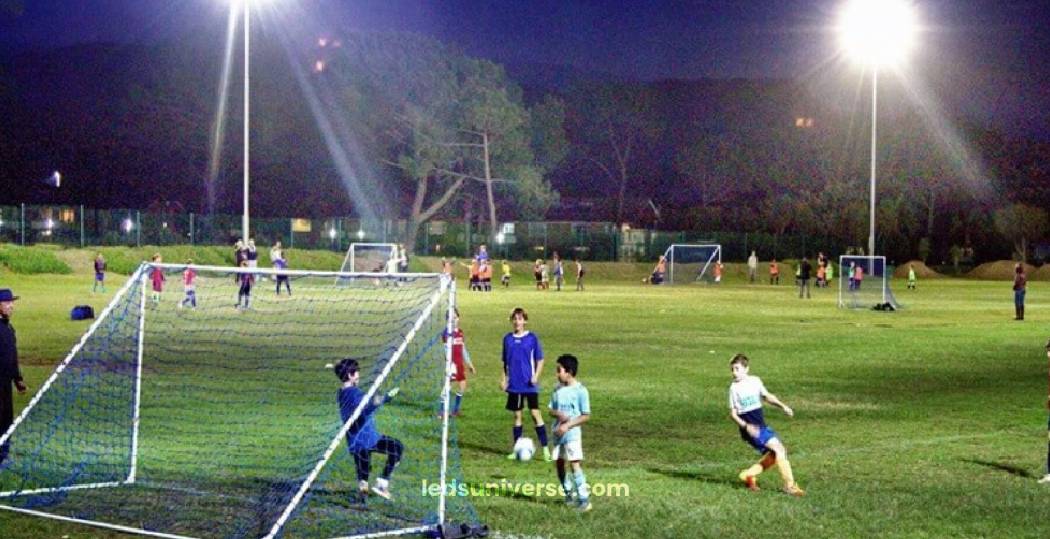From world-class arenas to local community fields, the adoption of solar technology is reshaping how venues operate, making them more energy-efficient while reducing their carbon footprint. But what exactly does this entail? What components make up these solar systems, and how do they benefit both the environment and the bottom line?
The advancement of solar technology has transformed various sectors, and sports facilities are no exception. Solar stadium lighting emerges as a sustainable alternative to traditional lighting systems, providing both ecological and economic benefits. As venues seek to reduce their carbon footprint and enhance the fan experience, the integration of solar lighting systems offers a promising solution.
Reach out for free lighting consultation
Table of Contents
ToggleThe functionality of solar stadium lighting systems hinges on several integral components that work harmoniously to ensure optimal performance and reliability. Understanding these components can illuminate how solar technology is effectively applied in sports arenas.

The heart of any solar lighting system is the solar panel. These panels capture sunlight and convert it into electricity, which is then used to power the lighting fixtures. The type of solar panel selected can greatly influence the overall efficiency of the system. Monocrystalline solar panels are often preferred for their high efficiency and durability, while polycrystalline panels provide a more cost-effective option. Regardless of the type, the goal is to maximize energy capture, especially during peak sunlight hours.
These batteries store the energy generated during the day, making it accessible for nighttime lighting needs. Lithium-ion batteries are commonly used due to their longevity and efficiency, allowing stadiums to operate effectively without relying solely on the grid. The ability to store energy ensures that the lighting remains consistent and reliable, regardless of weather conditions or time of day.
Lighting fixtures are another fundamental aspect of solar stadium lighting systems. The use of light-emitting diodes (LEDs) has gained traction due to their energy efficiency and longer lifespan compared to traditional incandescent bulbs. LEDs can provide brighter illumination while consuming significantly less energy, making them an ideal choice for illuminating large spaces like stadiums. Furthermore, LEDs can be programmed to adjust brightness levels based on ambient light conditions, optimizing energy usage.
The integration of smart technology within solar stadium lighting systems enhances their functionality. Smart sensors can adjust the lighting in real-time, responding to changing weather conditions or occupancy levels. This level of automation not only improves energy efficiency but also enhances the overall experience for spectators and athletes alike. With smart technology, stadiums can create a dynamic environment that adapts to the needs of the event, ensuring that lighting conditions are always optimal.
Solar stadium lighting presents an array of advantages that align with modern expectations for sustainability and innovation in sports facilities. As stadiums strive to create a more environmentally conscious image, the benefits of solar lighting systems become increasingly appealing.
One of the primary advantages of solar stadium lighting is its potential to reduce the carbon footprint of sports venues. By harnessing renewable energy, stadiums can significantly decrease their reliance on fossil fuels, contributing to a more sustainable energy landscape. This transition not only mitigates environmental impact but also aligns with global efforts to combat climate change. The installation of solar lighting systems can also enhance the overall sustainability initiatives of the stadium, showcasing a commitment to reducing environmental harm.
The economic benefits of solar stadium lighting are also noteworthy. Although the initial investment may be higher than conventional lighting systems, the long-term savings can be substantial. Lower electricity bills result from using solar energy, allowing stadium operators to allocate funds to other areas, such as facility maintenance or fan engagement initiatives. Additionally, various government incentives and rebates for renewable energy installations can further offset costs, making solar lighting a financially savvy choice for many venues. As the cost of solar technology continues to decrease, the return on investment for stadiums adopting solar lighting becomes even more attractive.
Enhancing the fan experience is another compelling reason to consider solar stadium lighting. The brightness and clarity provided by LED fixtures improve visibility during events, creating a more enjoyable atmosphere for spectators. Moreover, the aesthetic appeal of solar lighting can be leveraged for branding opportunities, allowing stadiums to showcase their commitment to sustainability while enhancing their image in the community. The ability to create vibrant lighting effects can also elevate the overall ambiance of events, further engaging fans and creating memorable experiences.
Another noteworthy aspect of solar stadium lighting is its reliability. With proper installation and maintenance, solar lighting systems can provide consistent illumination regardless of weather conditions. They can operate in various environments, from sunny regions to areas that experience frequent cloud cover. This versatility makes solar stadium lighting a viable option for venues worldwide. The robustness of solar lighting systems ensures that stadiums can maintain operations and provide safe lighting for fans and athletes alike.
Examining real-world examples of solar stadium lighting implementations provides valuable insights into the feasibility and impact of these systems. Several stadiums have successfully adopted solar technology, showcasing its advantages and paving the way for future projects.

One notable case is T-Mobile Park in Seattle, Washington. Home to the Seattle Mariners, this stadium has integrated solar energy into its lighting system. By installing solar panels on the roof, T-Mobile Park generates renewable energy to power its lighting and other electrical needs. This initiative not only reduces the stadium’s reliance on non-renewable energy sources but also demonstrates a commitment to sustainability. The project has resulted in a significant decrease in electricity costs, with the stadium reporting a remarkable reduction in its overall energy consumption.
Another example is the Moses Mabhida Stadium in Durban, South Africa. This venue, built for the 2010 FIFA World Cup, incorporated solar lighting systems into its design from the outset. The stadium features solar panels that power its lighting fixtures, providing a sustainable energy solution in a region where energy costs can be high. The implementation of solar lighting has allowed Moses Mabhida Stadium to operate more sustainably, enhancing its reputation as a forward-thinking facility. The integration of solar technology has also contributed to the stadium’s branding as a green venue, attracting events and sponsors aligned with sustainability values.
The San Diego Stadium has also made strides in solar lighting implementation. By retrofitting its existing lighting system with solar panels and LED fixtures, the stadium has drastically reduced its energy costs while improving illumination quality. The transition has been well received by both fans and players, creating a brighter and more inviting atmosphere during events. Additionally, the stadium has reported an increase in attendance and fan engagement since the upgrade, highlighting the connection between lighting quality and the overall spectator experience.
While the adoption of solar stadium lighting offers numerous advantages, it is not without its challenges and limitations. Addressing these concerns is vital for ensuring the successful implementation and long-term viability of solar lighting systems in sports venues.
One of the primary challenges associated with solar stadium lighting is the initial capital investment required for installation. While the long-term savings can be substantial, the upfront costs can deter some stadium operators from pursuing solar technology. The expense of purchasing solar panels, battery systems, and LED fixtures can be significant, particularly for venues with limited budgets. However, many operators find that government incentives and financing options can help mitigate these initial costs. This financial support can make solar lighting more accessible to a wider range of sports facilities, promoting the adoption of sustainable technologies.
Reliability is another concern, particularly in regions with inconsistent sunlight. Solar lighting systems depend on sufficient sunlight to generate electricity effectively. In areas prone to extended periods of cloud cover or inclement weather, the effectiveness of solar lighting may be compromised. To address this, many stadiums incorporate hybrid systems that can switch between solar and traditional energy sources, ensuring consistent illumination regardless of weather conditions. This adaptability allows venues to maintain lighting standards even in less-than-ideal circumstances.
Maintenance is also a factor to consider. Solar panels require regular cleaning to maintain efficiency, as dirt and debris can reduce their energy capture. Furthermore, battery systems must be monitored and occasionally replaced to ensure optimal performance. Stadium operators need to establish maintenance schedules and allocate resources to address these concerns, which may add to operational costs. A proactive approach to maintenance can help extend the lifespan of solar systems and ensure that they continue to operate at peak performance.
Regulatory and zoning issues can pose additional challenges. Depending on the location, there may be specific regulations regarding the installation of solar panels and the use of renewable energy sources. Stadium operators must navigate these regulations to ensure compliance, which can prolong the implementation process. Engaging with local authorities and stakeholders early in the planning phase can help identify potential obstacles and facilitate smoother project execution.
The perception of solar technology can also be a limitation. Some stakeholders may question the effectiveness of solar lighting systems, particularly if they have not experienced their benefits firsthand. Engaging with the community and demonstrating the value of solar technology through education and outreach initiatives can help alleviate these concerns. Hosting informational sessions, offering facility tours, and providing transparent data on energy savings can foster a more positive view of solar initiatives.
By understanding and addressing these challenges, stadium operators can create a more conducive environment for the successful integration of solar stadium lighting. Overcoming these hurdles paves the way for a more sustainable and efficient future in sports facility management.
Utilizing renewable energy allows stadiums to lower their carbon footprint while also realizing significant long-term cost savings. The various benefits of solar lighting—including positive environmental impacts, economic advantages, and improved fan experiences—highlight its potential to transform the operations of sports venues.